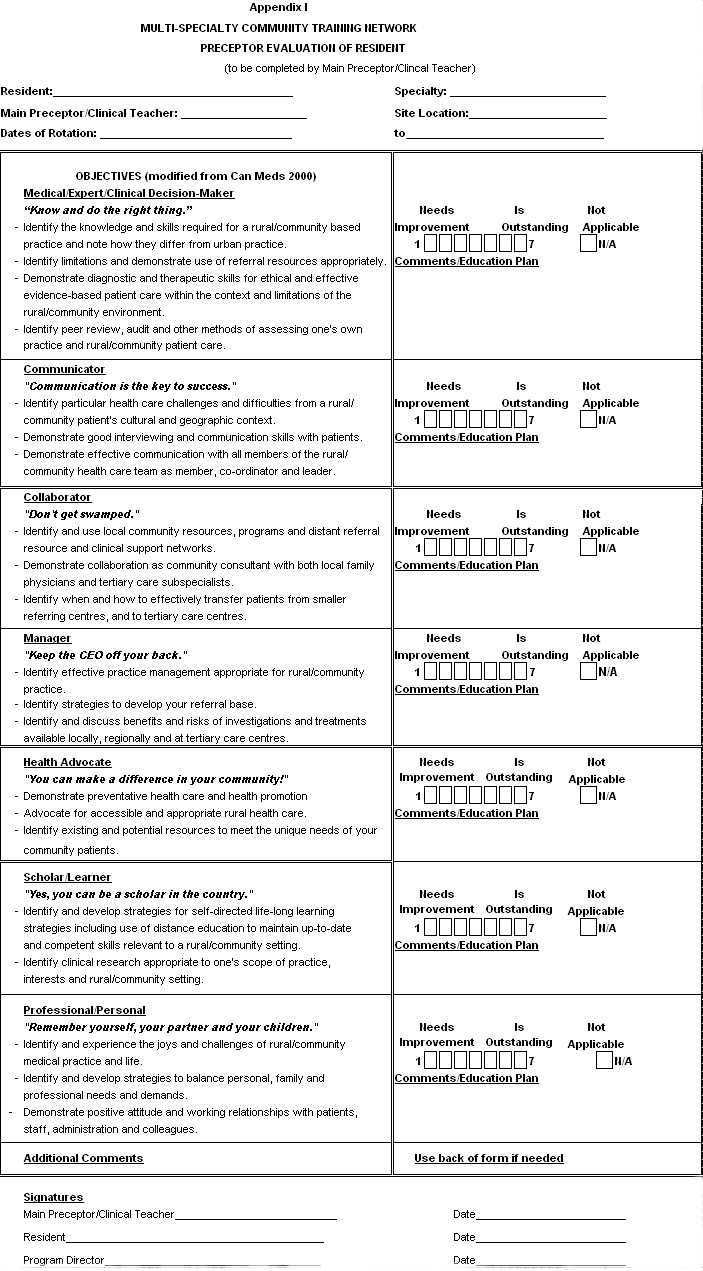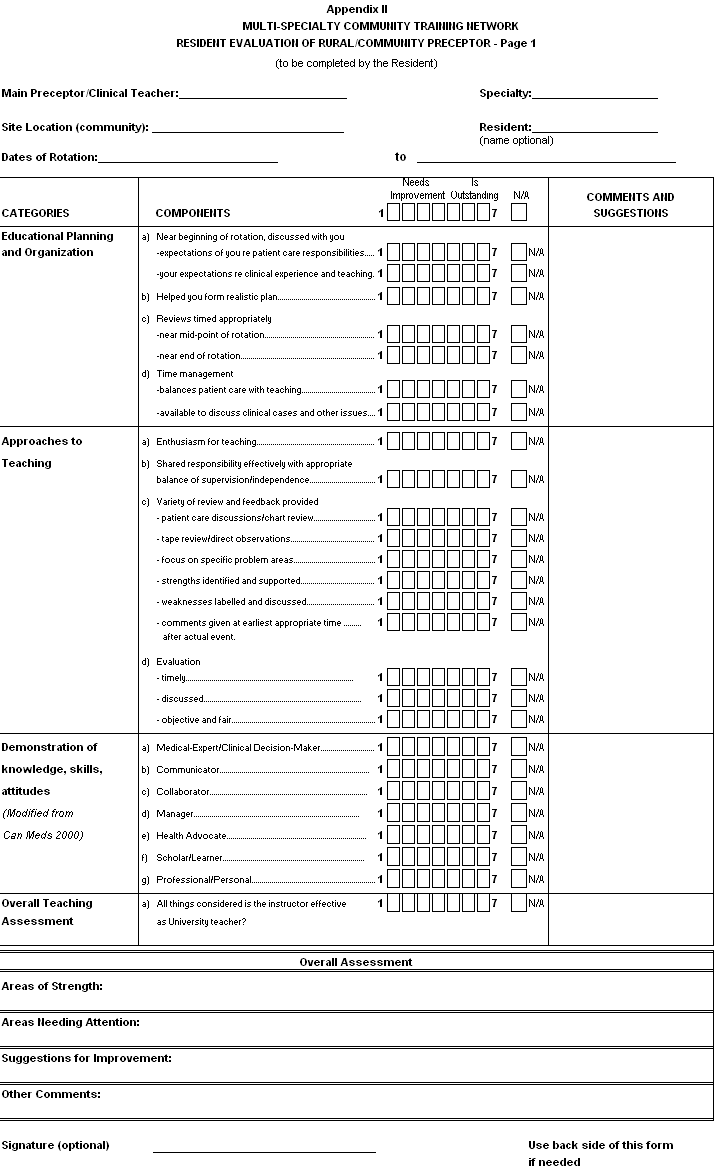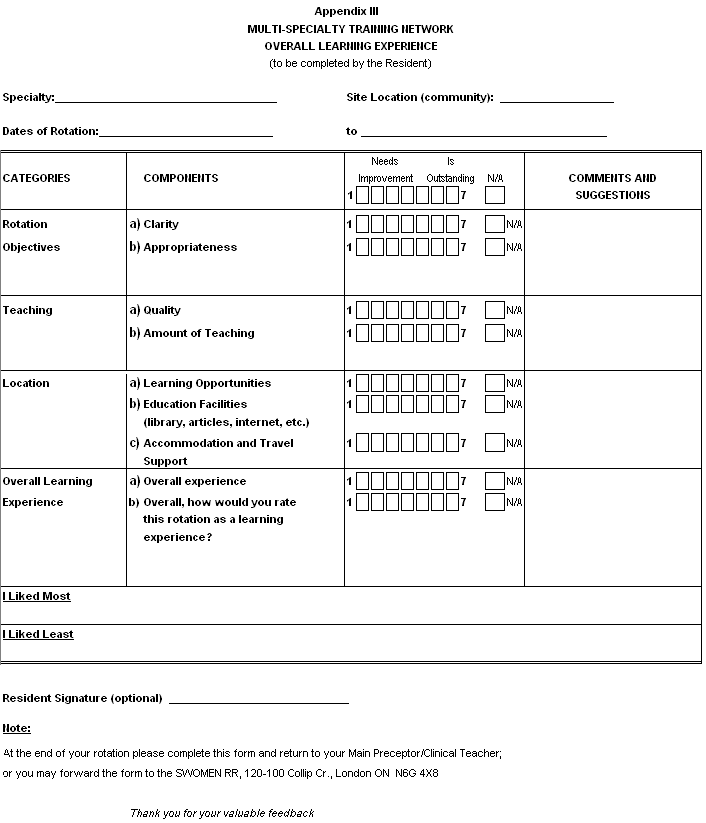Context
Since the 1990s there has been increasing attention paid to realigning the training of healthcare professionals to meet the needs of rural populations. There have been numerous developments incorporating rural medical education as a method to ensure rural physician competence and promote rural physician retention1-5. The majority of these have focused on primary care. However, the 1990s witnessed growing awareness of shortages of rural and regional specialist physicians. It was recognized that the practice skills and knowledge needed for rural/regional specialist physicians' practice setting were considerably different from the university hospitals where traditionally most, if not all, of the training for specialist physicians in Canada had taken place. There was a need to develop new approaches for specialist medical education that would better address these societal needs. Although rural learning experiences have been described in some specialty training programs, none appear to have focused on a societal needs competency framework6-22.
Issue
In the 1990s, the Royal College of Physicians and Surgeons of Canada (RCPSC) commissioned a task force to re-examine its core curriculum for specialist postgraduate medical education. The RCPSC (established in 1929) is the legal standard-setting body for specialist physicians in Canada, and is responsible for accrediting the specialist training programs at Canada's 17 medical schools. The RCPSC task force of the Societal Needs Working Group became the 'CanMEDS 2000 Project', commissioned to examine Canadian healthcare needs and assess their implications for postgraduate specialty training programs. CanMEDS' official goal was to '...identify the core competencies generic to all specialists to meet the needs of society'23. This project defined clusters of competencies referred to as 'physician roles'. These roles included: Medical Expert (the central role), Communicator, Collaborator, Health Advocate, Manager, Scholar, and Professional (Fig 1). In 1996, the RCPSC adopted the new framework which now forms the basis for the educational mission of the Royal College and has been incorporated into its standards for curriculum, accreditation, evaluation, examinations, and continuing professional development24-27. The roles and their key competencies are outlined (Fig 2). CanMEDSTM is described further elsewhere, and has subsequently been adopted by jurisdictions around the world28.
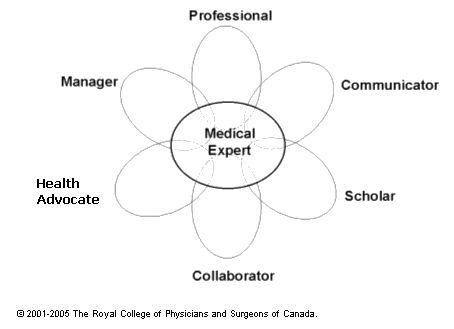
Figure 1: The CANMEDS roles framework.
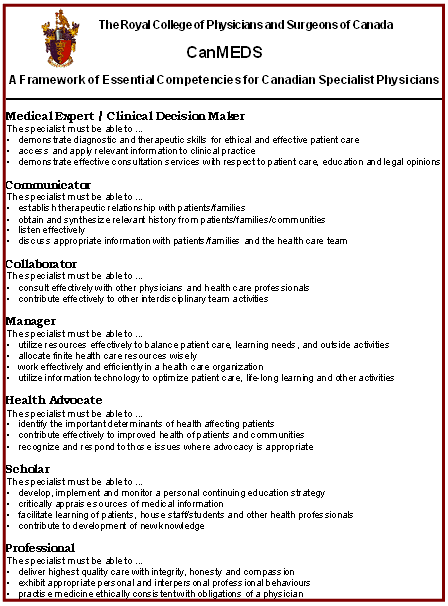
Figure 2: The 1996 CanMEDSTM Competency Framework. Copyright Royal College of Physicians and Surgeons of Canada 1996, reproduced with permission.
It was in response to the needs identified for rural specialist education and for societal-responsive CanMEDS competencies that the University of Western Ontario (London, Ontario, Canada) Faculty of Medicine and Dentistry (now the Schulich School of Medicine) established the Multi-Specialty Community Training Network (MSCTN) in 1997. The program was created to enhance the rural relevance of specialist education and to provide specialty residents the opportunity to perform part of their training in rural and regional settings. The MSCTN was designed to provide a rural and regional community-based component of specialty training that was evidence-based, needs-driven, and outcome-measured. It directly addressed the inherent challenges of adapting specialty training standards to rural settings. We describe the design, activities, evaluation tools, and preliminary outcomes of the MSCTN. Given the recent worldwide attention given to competency frameworks, CanMEDS, and rural medical education, we believe these findings will be of use to others interested in rural/regional and specialist medical education.
Program description
In Canada, there are 17 medical schools that provide the postgraduate residency training programs. These postgraduate residency training programs must meet the accreditation standards set by the College of Family Physicians of Canada for Family Medicine programs. These are 2 years in length but also include separate, optional 3rd year programs, such as emergency medicine. The postgraduate specialty training programs are usually 5-6 years in length and the accreditation standards are set by the Royal College of Physicians and surgeons of Canada.
The MSCTN was a collaborative consortium for postgraduate medical education based in and around the Southwestern Ontario region of Canada. The partnership included the University of Western Ontario (UWO) and a variety of communities and physicians in the region. The MSCTN had three principle goals:
- to enhance the rural competence of specialist residents
- to provide exposure to rural and regional community medical practice in order to promote rural and regional specialist recruitment
- to increase the understanding of rural and regional patient care among all specialty residents and university hospital faculty.
Program and evaluation design
One of the first important challenges faced in designing this program was to set objectives and evaluations that would be relevant to the residents involved the rural and regional settings and their preceptors, as well as the main full-time university specialty faculty. Through systematic consensus-building, the new RCPSC CanMEDS roles were adapted with the productive input of both university and community teaching faculty. Every effort was made to ensure the objectives were relevant to the rural and regional setting and to link the evaluations to the objectives in a simple form to facilitate completion, discussion, and analysis. These instruments are displayed (Appendix I).
After the resident objectives and evaluation form was developed, it was then felt to be congruent to include a section of the CanMEDS objectives in the form developed for evaluation of the preceptor (clinical teacher) to be completed by the resident (Appendix II). We added a question on the clarity and appropriateness of the objectives to the overall learning experience and site evaluation form to be completed by the residents (Appendix III).
The objective and evaluation tools were designed to be used by residents and preceptors during rural/regional rotations. Rotation length would be flexible, from one to six months, usually in the third postgraduate year of specialty training. Placement community population varied from 7500 to 75 000. All communities were in Southwest Ontario, a predominantly rural but not remote part of Canada with a shortage of both family physicians and specialists.
From July 1997 to June 2004, 174 residents completed 287 rural/regional placement months. All residents were in specialty training programs (general surgery, paediatrics, internal medicine, anaesthesia, obstetrics, psychiatry and other) except emergency medicine residents, who were undergoing a postgraduate year three program following completion of a 2 year family medicine residency training program. Community preceptors were predominantly RCPSC fellowship certified specialists in the above listed disciplines, practising in rural/regional communities.
For further program description and evaluation is published separately29. See also 'SWORRM: The First 5 Years and into the future', Section 8 Postgraduate: Multi-Specialty Community Training Network30. This detailed report can be accessed directly or through The University of Western Ontario, Schulich School of Medicine and Dentistry website31.
Lessons learned
The CanMEDS roles of physicians have provided a useful framework for adapting learning objectives and evaluation tools for UWO's rural and regional Multi-Specialty Community Training Network program. In the establishment of the program, the process of developing and aligning the CanMEDS roles was very positive in that it involved university and regional faculty; it helped solidify the learning objectives of the program and the evaluation process and so gained acceptance.
The use of objectives that have been developed to be relevant to the rural/regional setting have made them more useful to the participating residents and preceptors. Residents (n = 66) ratings of the clarity and appropriateness of the MSCTN objectives were high initially (5.37 on a Likert scale of 1-7 in the first year 1997-1998) and have increased since then (6.13 in 2001-2002).
Modifying the CanMEDS roles and competencies to be the MSCTN rural/regional specialty training objectives enabled residents' MSCTN training to fit into the overall specialty training, teaching and learning paradigm much better than separate unlinked objectives. This has become much more important over time for residents, preceptors and central faculty because the CanMEDS competencies have been accepted nationally as the core educational framework for RCPSC accredited specialty training
programs30.
Conclusion
The UWO MSCTN illustrates how the CanMEDS physician roles provide a very useful framework that can be specifically adapted to rural and regional specialty training. This adaptation has been useful for residents, regional faculty, departments, sites and programs involved as we strive to provide the most relevant, highest quality rural and regional training for our specialty residents. We believe that our experiences will be useful to other programs interested in further development of these roles and competencies and evaluation tools.
References
1. Rosenblatt RA, Whitcomb ME, Cullen TJ, Lishner DM, Hart LG. Which medical schools produce rural physicians? JAMA 1992; 268: 1559-1565.
2. Pathman DE, Steiner BD, Jones BD, Konrad TR. Preparing and retaining rural physicians through medical education. Academic Medicine 1999; 74: 810-820.
3. Rourke J (Chair) et al. for the Working Group on Postgraduate Education for Rural Family Practice. Postgraduate education for rural family practice: vision and recommendations for the new millennium: Report by the College of Family Physicians of Canada Working Group on Postgraduate Education for Rural Family Practice. Canadian Family Physician 1999; 45: 2698-2704.
4. Rabinowitz HK, Diamond JJ, Markham FW, Paynter NP. Critical factors for designing programs to increase the supply and retention of rural primary care physicians. JAMA 2001; 286: 1041-1048.
5. Curran V, Rourke J. The role of medical education in the recruitment and retention of rural physicians. Medical Teacher 2004; 26: 265-272.
6. Cameron DG. The role of the McGill Medical Faculty in support of the health services in northern Canada. Acta Socio-Medica Scandinavia 1972; Suppl 6: S108-S114.
7. Almy TP. A rural model. Journal of Medical Education 1975; 50: 44-48.
8. Crandall LA, Reynolds RC, Coggins WJ. Evaluation of a rural clinic rotation for medical residents. Journal of Medical Education 1978; 53: 597-599.
9. Maiuro RD, Trupin EW. Rural internships: fixed role therapy for the community mental health professional. Hospital & Community Psychiatry 1980; 31: 497-499.
10. Asher EF, Martin LF, Richardson JD, Polk HC. Rural rotations for senior surgical residents. Influence on future practice location. Archives of Surgery 1984; 119: 1120-1124.
11. Kairys S, Newell P. A rural primary care pediatric residency program. Journal of Medical Education 1985; 60: 786-792.
12. Petti TA, Benswanger EG, Fialkov MJ, Sonis M. Training child psychiatrists in rural public mental health. Hospital & Community Psychiatry 1987; 38: 398-401.
13. Boust SJ. State-university collaboration in Nebraska: public psychiatry residency training in a rural area. Hospital & Community Psychiatry 1991; 42: 49-51.
14. Bridges D. A public-academic partnership to train psychiatric residents in a rural mental health program. Hospital & Community Psychiatry 1994; 1: 66-69.
15. Gray JD, Steeves LC, Blackburn JW. The Dalhousie University experience of training residents in many small communities. Academic Medicine 1994; 69: 847-851.
16. Kanagarajah S. Changes in job aspirations during physician training in Australia. Australian and New Zealand Journal of Medicine 1996; 6: 26.
17. Mazwai E. Training surgically competent doctors for South Africa rural settings. South African Journal of Surgery 1999; 5: 147-148.
18. MacDonald WA. Medical teaching program in a rural northern hospital. International Journal of Circumpolar Health 1998; 57 Suppl 1: S83-S86.
19. Dewitt DE, Migeon M, Leblond R, Carline JD, Francis L, Irby DM. Insights from outstanding rural internal medicine residency rotations at the University of Washington, Research Report. Academic Medicine 2001; 76; 3.
20. Jensen CC. Dewitt DE. The reported value of rural internal medicine residency electives and factors that influence rural career choice. Columbia, SC: Rural Crossroads, 2002.
21. Hunter JG, Deveney KE. Training the rural surgeon: a proposal. Bulletin of the American College of Surgeons 2003; 88: 13-17.
22. Vangelisti GR. Training in rural surgery: a resident's perspective. Bulletin of the American College of Surgeons 2003; 88: 18-20.
23. Frank JR. The CanMEDS Project: The Royal College of Physicians and Surgeons of Canada moves medical education into the 21st century. In: HB Dinsdale, G Hurteau (Eds). The Evolution of Specialty Medicine, 1979-2004. Ottawa: RCPSC, 2004; 187-211.
24. Frank JR, Tugwell P (Chair) et al. Skills for the New Millennium: Report of the Societal Needs Working Group. Ottawa: Royal College of Physicians and Surgeons of Canada, 1996.
25. Tugwell P (Chair) et al. Skills for the New Millennium: Societal Needs Working Group CanMEDS 2000 Project. Annals RCPSC 1996; 29: 206-214.
26. Frank JR, Tugwell P (Chair) et al. CanMEDS 2000. Medical Teacher 2000; 22: 549-554.
27. Frank JR, LANGER B. Collaboration, communication, management and advocacy: Teaching surgeons new skills through the CanMEDS Project. World Journal of Surgery 2003; 27: 972-978.
28. The Royal College of Physicians and Surgeons of Canada. CanMEDS. (Online) 2005. Available: http://rcpsc.medical.org/canmeds (Accessed 20 July 2005).
29. Rourke J. A Rural and Regional Community Multi-specialty Residency Training Network developed by the University of Western Ontario. Teaching and Learning in Medicine 2005; 17. (In press).
30. SWORRM: Education, Research and Development. Multi-Specialty Community Training Network. (Online) no date. Available: http://www.sworm.on.ca/5year/08_postgraduate.pdf (Accessed 20July 2005).
31. SWOMEN Southwestern Ontario Medical Education Network (Online) no date. Available: http://www.med.uwo.ca/education/SWOMEN (Accessed 20 July 2005).
32. Frank JR. The CanMEDS Project: The Royal College of Physicians and Surgeons of Canada moves medical education into the 21st century. Royal College Outlook 2004; 1: 27-29.



